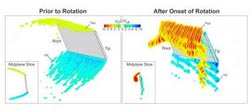The secrets of a bug's flight

The left image represents a non-rotating wing in the presence of incident flow; it exhibits a stalled state. The right image, taken shortly after the onset of rotation (at 36 degrees), shows a stable, lift-generating flow structure.<br><br>Credit: Matthew Bross<br>
Researchers have identified some of the underlying physics that may explain how insects can so quickly recover from a stall in midflight — unlike conventional fixed wing aircraft, where a stalled state often leads to a crash landing.
The analysis, in which the researchers studied the flow around a rotating model wing, improves the understanding of how insects fly and informs the design of small flying robots built for intelligence gathering, surveillance, search-and-rescue, and other purposes. The work is described in the journal Physics of Fluids.
An insect such as a fruit fly hovers in the air by flapping its wings — a complex motion akin to the freestyle stroke in swimming. The wing rotates in a single plane, and by varying the angle between the plane and its body, the insect can fly forward from a hovering position.
To simulate the basics of this action, Matthew Bross and colleagues at Lehigh University in Bethlehem, PA, studied how water flows around a rotating model wing consisting of a rectangular piece of acrylic that is twice as long as it is wide. The rotation axis is off to the side of the wing and parallel to its width, so that it rotates like half of an airplane propeller. To simulate forward motion — a scenario in which the insect is accelerating or climbing — the researchers pumped water in the direction perpendicular to the plane of rotation.
“We were able to identify the development of flow structure over an insect-scaled wing over a range of forward flight velocities,” Bross explained. The researchers made detailed three-dimensional computer visualizations of the flow around the wing, finding that a leading-edge vortex — a feature crucial for providing lift — almost immediately appears once the wing starts to rotate after a stalled state.
The article, “Flow structure on a rotating wing: effect of steady incident flow,” by Matthew Bross, Cem Alper Ozen and Donald Rockwell appears in the journal Physics of Fluids. See: http://dx.doi.org/10.1063/1.4816632
ABOUT THE JOURNAL
Physics of Fluids is devoted to the publication of original theoretical, computational, and experimental contributions to the dynamics of gases, liquids, and complex or multiphase fluids. See: http://pof.aip.org
Media Contact
More Information:
http://www.aip.orgAll latest news from the category: Physics and Astronomy
This area deals with the fundamental laws and building blocks of nature and how they interact, the properties and the behavior of matter, and research into space and time and their structures.
innovations-report provides in-depth reports and articles on subjects such as astrophysics, laser technologies, nuclear, quantum, particle and solid-state physics, nanotechnologies, planetary research and findings (Mars, Venus) and developments related to the Hubble Telescope.
Newest articles

Bringing bio-inspired robots to life
Nebraska researcher Eric Markvicka gets NSF CAREER Award to pursue manufacture of novel materials for soft robotics and stretchable electronics. Engineers are increasingly eager to develop robots that mimic the…

Bella moths use poison to attract mates
Scientists are closer to finding out how. Pyrrolizidine alkaloids are as bitter and toxic as they are hard to pronounce. They’re produced by several different types of plants and are…

AI tool creates ‘synthetic’ images of cells
…for enhanced microscopy analysis. Observing individual cells through microscopes can reveal a range of important cell biological phenomena that frequently play a role in human diseases, but the process of…





















